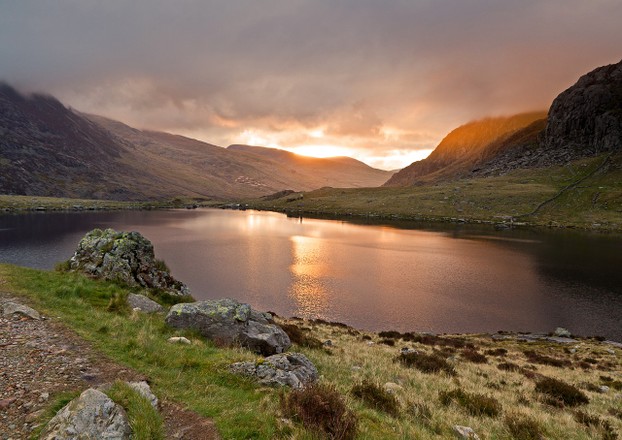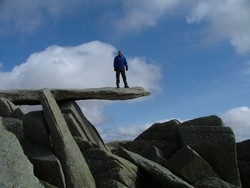"You shouldn't have gone round widdershins." my philosophy lecturer interjected as I was sitting in the lecture room awaiting the commencement of the lecture and speaking to my friend Cahal about the weekend's walk that had not gone as planned. Of course, walking in North Wales in October when the clouds are all too often borne in by strong winds is asking for some risk, and I was doing the walk alone. But widdershins, anticlockwise, the concept had never crossed my rational mind, and here was a philosophy lecturer using the term! He did not elaborate on his thoughts and I did not ask for clarification, but I knew him to be no ivory tower academic, but a man rich in life and mountain walking experience.There is more in heaven and earth than is dreamed of in Philosophy.
I had begun the walk by starting at the opposite end of the horseshoe of peaks that comprise the Idwal skyline, Y Garn. This part of the route begins at Llyn Idwal, a bleak mountain lake set in an armchair of harsh peaks. At first the going was straightforward, the path led upwards with no difficulty, but I paid too little heed to the fast moving clouds that scoured the summit. But at three thousand feet the wind hit me hard. The summit was covered in a mist of fast moving cloud; and it was very cold. I know enough to recognize wind chill when I encounter it. The cold wind was eating into my body,well equipped as I was, and I knew that the safest option was to abort the walk. I came down by the most direct route available, not the one by which I had ascended, as the mist was disorientating me, but the quickest and easiest route. Lesson learned with no harm done.
The conventional commencement of the route is via Tryfan, the mountain that you see below in the picture, it is a stark mass of rock with three routes upwards. Two, the Heather Terrace, the easiest route and safest route, which you can see as a white scar on the mountainside, and the route from Cwm Idwal [Idwal valley] which is hidden on the far side of the picture, ascend to Bwlch Tryfan, the col between Tryfan and Glydr Fach, from which there is access to the two peaks. But the route up Tryfan is a scramble up rugged rock to the summit. The North Ridge, which you can see fully in the picture, involves more than walking, for at times you have to scramble and it is known as a demanding route. I have been ascending the ridge when jet fighters passed below me, for the Ogwen Valley at the bottom, from which the picture below was taken,is a training ground for jet pilots based in nearby Anglesey.
At the summit of Tryfan there are two pillars, Adam and Eve, and the most daring of people like to jump from one to the other, daring the drop. I have never done the jump.









 Women of the Gospelson 10/11/2025
Women of the Gospelson 10/11/2025
 Religious Gardenson 08/25/2025
Religious Gardenson 08/25/2025
 Doctor of the Church: John Henry Newmanon 08/03/2025
Doctor of the Church: John Henry Newmanon 08/03/2025
 Restoring the Palm Houseon 07/16/2025
Restoring the Palm Houseon 07/16/2025



Comments
The Highlandsvoffer long distances, rocky ridgES, terrain to walk. In other words the difficulties that you get in the south are magnified in Scotland.
Thank you for your comment below in answer to my previous observation and question.
The introductory paragraph advises us that "While none can match the difficulties of the Scottish Highlands, the Idwal Skyline makes a strong claim to be up there with the hard routes."
What are the unmatchable difficulties that the Scottish Highlands display?
They sure do.
Thank you for your comment below in answer to my previous observation and question.
So the jump description depicts its dangerousness. Your climbing, running, walking sons -- trek-lovers like their parents -- know to keep away too, don't they?
It is a dangerous jump and IMHAVE never done it.
Thank you for your comment below in answer to my previous observation and question.
The jump somewhat unsettles me. Would the landing be quite a jolt to the weight-bearing feet? Would it be possible to get (albeit hairline) fractures?
The jump is short, but exposed. You jump from the taller to the shorter and then drop down a few feet back to the summit.
FrankBeswick, What is involved in jumping from the Adam to the Eve pillars? Does the jump place the jumper on the way down or does he/she have to jump back to the summit?
An amazing mountain walk.
I forget to say that the view from the summits is of Snowdon, Wales Highest peak.